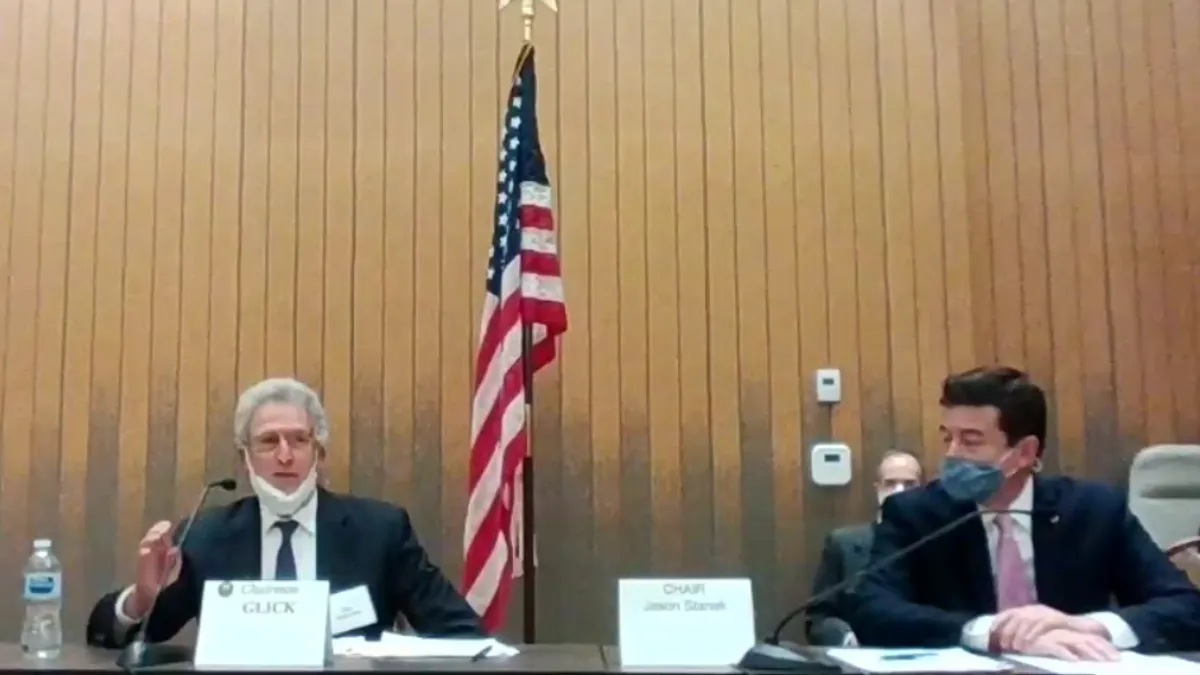Dive Brief:
- The Federal Energy Regulatory Commission on Wednesday convened the first meeting of a new task force on electric transmission development, asking 10 state regulators to discuss potential market reforms, and approaches to siting and public policy.
- The task force is a joint initiative between FERC and the National Association of Regulatory Utility Commissioners and will run for an initial three-year term. It may result in recommendations to FERC, including new regulatory language or initiatives to improve transmission development.
- State regulators made clear they want to work collaboratively — but barriers were also on display at the meeting, which ran more than four hours. "If FERC attempts to reform planning by requiring consideration of state perspectives and energy related goals, I fear that it will impair the ability to get transmission built," warned Commissioner Kristine Raper of the Idaho Public Utilities Commission.
Dive Insight:
Much of Wednesday's joint task force meeting was spent introducing state perspectives and broadly discussing what issues limit transmission development. But the meeting did delve into specific questions, in particular whether FERC should alter regional transmission planning process to give states a bigger role.
Some issues related to transmission investment are clearly within FERC's jurisdiction, said FERC Chairman Richard Glick, while others fall within the state's purview.
"I've said this a million times, but there's no need to look at this as solely a FERC issue or solely a state issue. We need to work together on this issue," Glick said. "I think it's very important for the public interest ... that we put aside some of our jurisdictional differences at times, and see if we can work together."
State regulators responded with a mix of optimism and caution.
Requiring consideration of state policies and energy goals, said Raper, will slow down the process "because the energy goals are the polarizing part of a conversation."
Reliability must remain the key consideration, she said. If FERC mandates a role for states in the transmission planning process, it "would likely increase friction."
Pennsylvania Public Utility Commission Chairman Gladys Brown Dutrieuille said FERC should be "cautious of mandating additional proactive planning drivers" that are not based on secured financial commitments for proposed generator interconnections or building the transmission system "to accommodate preferred but uncertain generation development."
There are examples where a heavier state involvement has worked. Task force members discussed the 14-state Southwest Power Pool's (SPP) model, which uses a regional state committee to address issues like cost allocation.
"Arkansas customers have received significant benefits from participating in [regional transmission organization (RTO)] markets," Arkansas Public Service Commission Chairman Ted Thomas said.
Thomas currently serves as a member on SPP's regional state committee, and he also warned the task force members that Arkansas earned those benefits "by spending countless hours in RTO stakeholder meetings, talking about transmission planning and cost allocation, and all of these topics that we're going to study in detail today and as the task force develops."
SPP has some of the lowest wholesale energy prices in the nation, said Kansas Corporation Commission Chairperson Andrew French, but transmission constraints can at times lead to negative pricing and it is important to acknowledge that the benefits of transmission development do not accrue evenly.
"The load in Kansas tends to be on the far eastern side of the state, and in a different pricing zone," French said. "You have to make sure that to the extent you're developing energy resources and transporting those energy resources, the costs of that do not fall on customers who happen to reside in a renewable rich area, simply because they reside there."
The benefits of initiatives to develop transmission, however, "are uneven," said French.
"Throughout the nation, many benefits will flow to large load centers," he said. "Kansas is not a large load center or a growing load center. But we do want to be a partner to help meet demand for new renewable energy resources."
Multiple states highlighted the complexity of working in divided territories or with multiple RTOs. North Carolina, for instance, has two utilities not in a RTO and another one operating within the PJM Interconnection's territory. "We've seen some transmission issues popping up there," said Commissioner Kimberly Duffley of the North Carolina Utilities Commission.
"Understanding how seams work, the benefits of both and then lessons that may have broader application ... I think it is valuable," said Dan Scripps, Michigan Public Service Commission chair.
Michigan's perspective can be valuable as it is a part of two RTOs, said Scripps. Most of the state is in the Midcontinent ISO territory, while a portion of its lower peninsula is in PJM.
During the meeting, he implored fellow task force members to look at future needs rather than the system today.
"When you think about the increasing frequency and severity of extreme weather, combined with an ongoing and indeed increasing transformation of our generation fleet, we need to think about what transmission is going to be needed," Scripps said. "There are a lot of different perspectives on that here."














